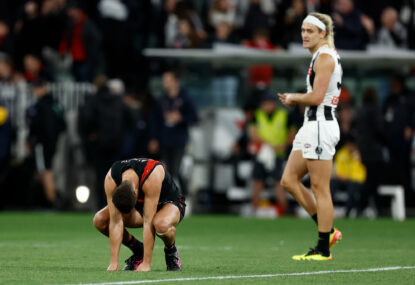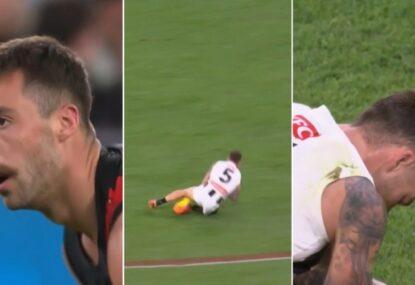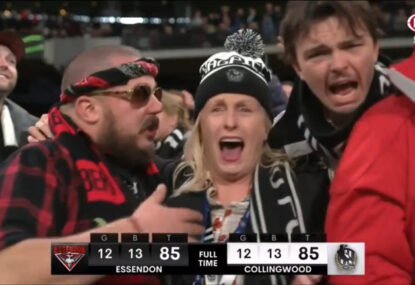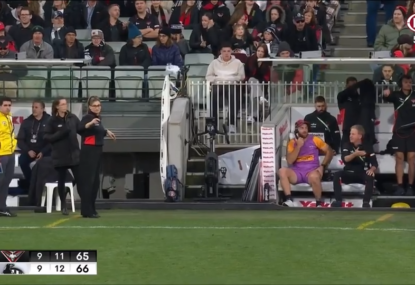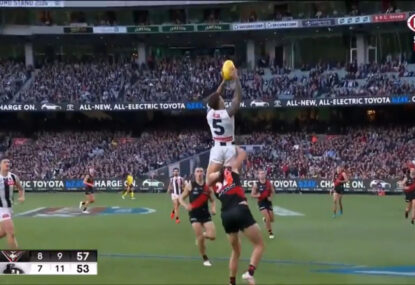It was sometime around midmorning on the last day of the trial when Justice John Middleton’s normally unfailing affability finally failed him.
“You can keep calling it a ‘joint investigation’ until we’re all red in the face”, he said. “But I’m the one who has to work out what that actually means!”
It made you wonder if we’d made any headway at all in the preceding two days, indeed in the preceding two months.
An Essendon strategy since commencing the action on June 13 had been to keep repeating those two words – joint investigation – until the automatic unlawfulness of such a thing would seem virtually unchallengeable.
For ASADA to conduct any kind of joint investigation was to operate beyond its powers. End of story.
But when they subsequently began to place more and more emphasis on the second and lesser ground of their action, it seemed like they were belatedly regretting having oversold the first.
The second ground of their action was that both the conduct of the investigation and the use of the information obtained from it were for improper purposes.
One such improper purpose was to make then Federal Sports Minister, Kate Lundy, look good. Lundy had been under pressure from Cabinet colleagues who were concerned that the doping scandal and the slow progress in dealing with it was making the government look ineffectual by association.
Another such improper purpose was to make then AFL boss, Andrew Demetriou, look good. Demetriou was under pressure from practically everybody to get the scandal out of the headlines before it ruined the 2013 finals series and to demonstrate to the world that any suspicion of performance-enhancing drug use would not be tolerated on his watch, which was drawing to a close.
Something of a Catch-22, you’d think.
Apparently he and the second applicant weren’t on such great terms, either.
Other improper purposes were to keep a ragtag assortment of brand managers, media advisers, departmental operatives and ticket-sellers happy, or at least quiet.
But the main impropriety was the use of the investigation and the Interim Report fashioned from it for the purpose of allowing the AFL to punish the Essendon Football Club and its leaders for their governance failures and generally “toxic” management culture.
Essendon and Hird say that in yielding to these external pressures to release a half-baked report ASADA was acting for everybody else’s improvised purposes and not for its own statutory purpose, which they say was strictly defined.
ASADA’s statutory purpose, they say, was to investigate anti-doping violations. If it could share confidential information at all, it could share it for the direct purpose of investigating anti-doping violations.
It could not share it for the purpose of good public relations or discouraging bad management practices.
It certainly could not allow, on a tricky technicality, the transcripts of interviews and the results of forensic analysis to find their way into the hands of people who were not bound by the same strict confidentiality laws that ASADA was, to use for whatever purpose took their fancy.
Neil Young QC for Essendon, gave due expression to this second and lesser ground (which Peter Hanks, QC, for Hird, preferred to characterise as “intertwined and inseparable” from the first). Young said “the wholesale and immediate release of unvetted and unconsidered information to parties who, once they received it, were not bound by the same restrictions” was an improper purpose.
That said, there was no retreating from the first line of attack – a joint investigation is illegal whether you scream through a megaphone a hundred times or whisper it once under your breath. The statute does not allow it, he said. The statute prohibits it. This joint investigation was illegal. Simple as that.
Young has a mind like a jeweller’s stone. He deals in precise meaning and pared down language. His arch-adversary in this case, Tom Howe QC, is rather more extravagant.
On Monday morning Howe had mocked Essendon’s argument that the AFL and ASADA were pursuing totally different purposes as “nonsense on stilts”. He didn’t quite understand how Essendon’s “disgraceful and toxic management culture” in 2012 was supposed to be unrelated to the rampant experiment in pharmacology that occurred in that same year.
He thought the two things were probably connected. And that connection was all ASADA needed to make the joint investigation lawful.
Howe said a plain reading of the Act made it abundantly clear that parliament always intended ASADA would use the “robust contractual arrangements” of sporting administration bodies like the AFL for its own investigative purposes.
The codes had been directed to adopt “robust contractual arrangements” with players and clubs for precisely the purpose of making their compulsive powers available to ASADA.
The fact that the carefully-considered amendments to the ASADA Act last year still withheld those compulsive powers from the anti-doping authority supported this reading, he said.
In the shadows of the late afternoon Justice Middleton asked the parties what they each thought should happen to the show cause notices in the event that he found in their favour, or for that matter not in their favour.
In the public gallery, heads lifted and backs straightened immediately. Amid all that plain language we’d almost forgotten about the show cause notices and the 34 players who received them.
We know some pretty dubious things occurred in those “interrogative interviews” the players were subjected to. But we knew that at the start. Here we are at the end of the trial we know next-to-nothing more.
Did any of the players turn to an ASADA interrogator and say, “Hey, mate, are you allowed to do this? What about those common law rights people talk about? Do I have them?”
If so, how many players? One? Two? Six? None? Did their lawyers do it?
The fierce adversaries at the bar table seem to be in furious agreement that they should all steer well clear of that – each for their own different reasons, one suspects.
The show cause notices? The Essendon and Hird lawyers told Justice Middleton that if he finds their way the notices should be set aside, the investigation shut down and the illegally-obtained evidence buried some place where no one is likely to find it, not in a hurry anyway.
David Grace QC, representing the 34 ghosts of the civil dead, said they should be afforded the same relief.
Tom Howe wasn’t too fussed either way. Find against us, Your Honour, and we’ll just do it all over again.





























































































